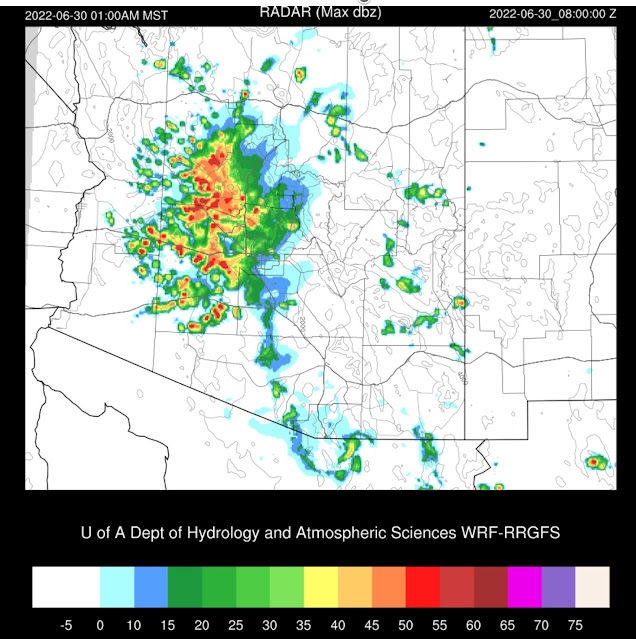Previous Forecast
It was another active day, especially for SW Arizona. June, really? New Mexico got hammered again, especially in the north. Storms mostly stayed out of the Tucson and Phoenix area.
Generally, the model forecasts were pretty good, except for the typical problem of not enough precipitation. The WRFHRRR has been quite the enigma this year. It seems to do poorly regarding precipitation with weaker storms, but with stronger storms, like those in SW Arizona, it does OK. It was also one of the better runs in NM.
Discussion
The second in a series of tropical systems is now impacting Arizona and Sonora. Celia has moved close enough to the Gulf of California to increase moisture there significantly. Hermosillo has a PW of 51 mm, for example.
A sprawling 500mb anticyclone is present from coast to coast. Over the western CONUS and into Mexico, the height field is remarkably uniform, resulting in very light winds. There is a mid to upper-level trough over far southwestern Arizona, which appears to be the main reason for the previous activity there.
The Tucson sounding has a bit of CAPE and a deeply saturated and cloudy layer. Most of southeastern and eastern Arizona have widespread clouds and even a few showers. Note the northerly winds between 500 and 700mb. Part of the reason for so many clouds is an MCV, spinning over Santa Cruz County. I didn't think deep convection in Sonora last night was strong enough to produce such an obvious MCV. Maybe the night before?
These things are always a crap shoot. Either they cut off heating and not much happens, or they provide some organization to storms that form on the edge of the clouds or both.
InitializationsThey are in for a challenge today! I was surprised that all initializations since 6Z had clouds and showers initialized accurately. However, all struggled with the MCV, which isn't too surprising. The 6Z initializations completely missed the circulation, but since then, they've at least had a cyclone circulation over SE Arizona. Close enough, IMO. As this is such a complicated situation, I looked at the IPW errors. Once again, errors, including in NW Mexico, where it's very moist, were minimal. NCEP was up to the challenge, so I think model performance should be good, with no particular favorite.

Day 1
A weak surge is underway in southwestern Arizona, and by later in the morning, it becomes stronger, resulting in increasing moisture for southern Arizona. PW
850mb dewpoints are generally in the favorable range of around 10C. The air mass isn't as wet as it could be, but it is still only June. There is subsidence and drying over southern NM, attempting to move into SE Arizona.
CAPE isn't all that impressive with the exception being southwestern Arizona. It is sufficient to support deep convection over much of the date, especially over the mid and high terrain.
Scattered storms develop over much of the higher terrain of northern Arizona by mid-afternoon.

CAPE doesn't increase for the Tucson area and is only around 200-400 J/kg. The vertical wind profile is mainly light and variable, so storms will likely form over the higher terrain and not move much. Anvils will blow over the valley resulting in only limited activity, at best. This is assuming it can clear up, which looks unlikely from satellite trends. Also, the model forecast 2m temperatures are running 2-3C too warm.
Again, Phoenix looks more favorable for activity than Tucson. This shows you what a strange beginning to the monsoon where Phoenix has seen a lot more activity than Tucson. CAPE is sufficient for a few storms, the vertical wind profile has a bit of directional shear, and the PBL is well mixed.
Storms to the north of Phoenix move/propagate slowly south, and by early evening, strong storms are scattered over the lower elevations of southcentral to western Arizona. Many runs also develop storms around Tucson, but I think they are overdoing it.
CAPE increases over southwestern Arizona, with a slight risk of severe weather as a broken line of storms moves into this very unstable air.
It's unlikely that storms will make it as far as Yuma as a strong cap is present. It will take a strong outflow boundary to break it.
Strong to severe storms over western and southwestern Arizona and western NM gets hit again! The Arizona storms peter out as they move to the SW as outflow boundaries are not strong enough to break the cap.
Day 2
Typically after an active day, the next day is a down day as the atmosphere has been cooled and stabilized. In addition, dry air advection from southwestern NM is occurring in southeastern Arizona.























































